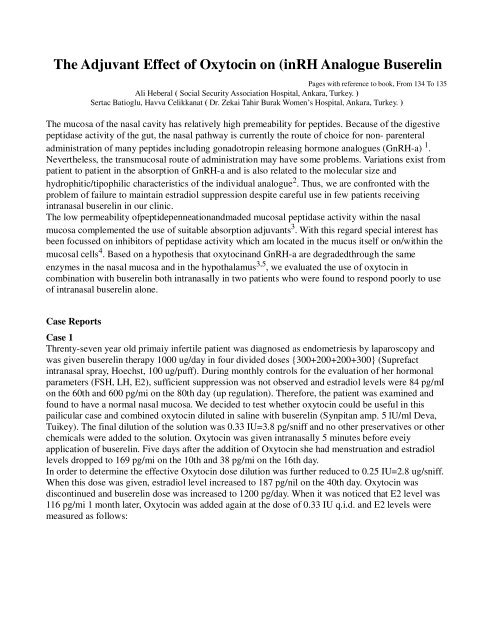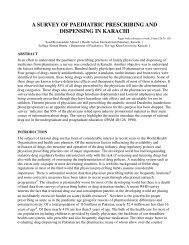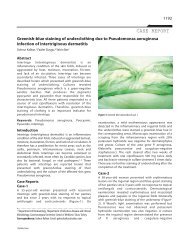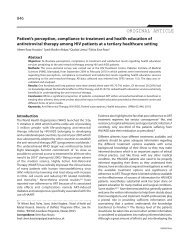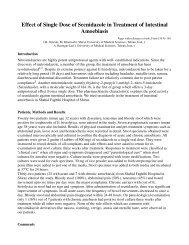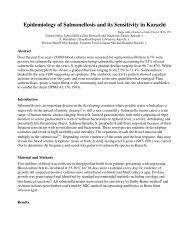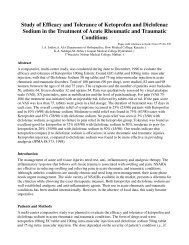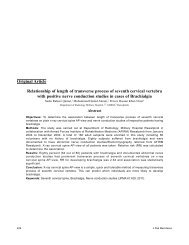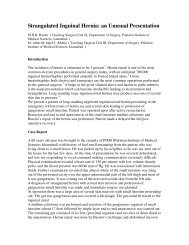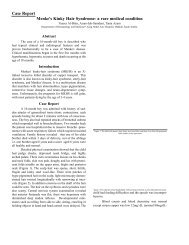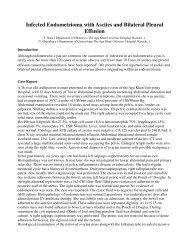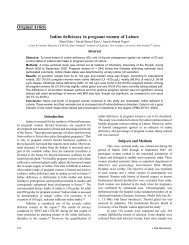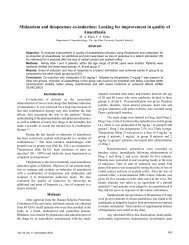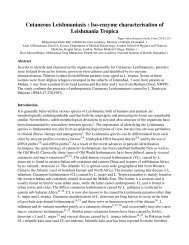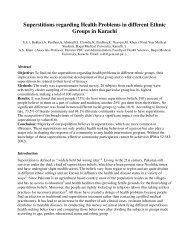The Adjuvant Effect of Oxytocin on (inRH Analogue Buserelin
The Adjuvant Effect of Oxytocin on (inRH Analogue Buserelin
The Adjuvant Effect of Oxytocin on (inRH Analogue Buserelin
Create successful ePaper yourself
Turn your PDF publications into a flip-book with our unique Google optimized e-Paper software.
<str<strong>on</strong>g>The</str<strong>on</strong>g> <str<strong>on</strong>g>Adjuvant</str<strong>on</strong>g> <str<strong>on</strong>g>Effect</str<strong>on</strong>g> <str<strong>on</strong>g>of</str<strong>on</strong>g> <str<strong>on</strong>g>Oxytocin</str<strong>on</strong>g> <strong>on</strong> (<strong>inRH</strong> <strong>Analogue</strong> <strong>Buserelin</strong><br />
Pages with reference to book, From 134 To 135<br />
Ali Heberal ( Social Security Associati<strong>on</strong> Hospital, Ankara, Turkey. )<br />
Sertac Batioglu, Havva Celikkanat ( Dr. Zekai Tahir Burak Women’s Hospital, Ankara, Turkey. )<br />
<str<strong>on</strong>g>The</str<strong>on</strong>g> mucosa <str<strong>on</strong>g>of</str<strong>on</strong>g> the nasal cavity has relatively high premeability for peptides. Because <str<strong>on</strong>g>of</str<strong>on</strong>g> the digestive<br />
peptidase activity <str<strong>on</strong>g>of</str<strong>on</strong>g> the gut, the nasal pathway is currently the route <str<strong>on</strong>g>of</str<strong>on</strong>g> choice for n<strong>on</strong>- parenteral<br />
administrati<strong>on</strong> <str<strong>on</strong>g>of</str<strong>on</strong>g> many peptides including g<strong>on</strong>adotropin releasing horm<strong>on</strong>e analogues (GnRH-a) 1 .<br />
Nevertheless, the transmucosal route <str<strong>on</strong>g>of</str<strong>on</strong>g> administrati<strong>on</strong> may have some problems. Variati<strong>on</strong>s exist from<br />
patient to patient in the absorpti<strong>on</strong> <str<strong>on</strong>g>of</str<strong>on</strong>g> GnRH-a and is also related to the molecular size and<br />
hydrophitic/tipophilic characteristics <str<strong>on</strong>g>of</str<strong>on</strong>g> the individual analogue 2 . Thus, we are c<strong>on</strong>fr<strong>on</strong>ted with the<br />
problem <str<strong>on</strong>g>of</str<strong>on</strong>g> failure to maintain estradiol suppressi<strong>on</strong> despite careful use in few patients receiving<br />
intranasal buserelin in our clinic.<br />
<str<strong>on</strong>g>The</str<strong>on</strong>g> low permeability <str<strong>on</strong>g>of</str<strong>on</strong>g>peptidepenneati<strong>on</strong>andmaded mucosal peptidase activity within the nasal<br />
mucosa complemented the use <str<strong>on</strong>g>of</str<strong>on</strong>g> suitable absorpti<strong>on</strong> adjuvants 3 . With this regard special interest has<br />
been focussed <strong>on</strong> inhibitors <str<strong>on</strong>g>of</str<strong>on</strong>g> peptidase activity which am located in the mucus itself or <strong>on</strong>/within the<br />
mucosal cells 4 . Based <strong>on</strong> a hypothesis that oxytocinand GnRH-a are degradedthrough the same<br />
enzymes in the nasal mucosa and in the hypothalamus 3,5 , we evaluated the use <str<strong>on</strong>g>of</str<strong>on</strong>g> oxytocin in<br />
combinati<strong>on</strong> with buserelin both intranasally in two patients who were found to resp<strong>on</strong>d poorly to use<br />
<str<strong>on</strong>g>of</str<strong>on</strong>g> intranasal buserelin al<strong>on</strong>e.<br />
Case Reports<br />
Case 1<br />
Threnty-seven year old primaiy infertile patient was diagnosed as endometriesis by laparoscopy and<br />
was given buserelin therapy 1000 ug/day in four divided doses {300+200+200+300} (Suprefact<br />
intranasal spray, Hoechst, 100 ug/puff). During m<strong>on</strong>thly c<strong>on</strong>trols for the evaluati<strong>on</strong> <str<strong>on</strong>g>of</str<strong>on</strong>g> her horm<strong>on</strong>al<br />
parameters (FSH, LH, E2), sufficient suppressi<strong>on</strong> was not observed and estradiol levels were 84 pg/mI<br />
<strong>on</strong> the 60th and 600 pg/mi <strong>on</strong> the 80th day (up regulati<strong>on</strong>). <str<strong>on</strong>g>The</str<strong>on</strong>g>refore, the patient was examined and<br />
found to have a normal nasal mucosa. We decided to test whether oxytocin could be useful in this<br />
pailicular case and combined oxytocin diluted in saline with buserelin (Synpitan amp. 5 lU/ml Deva,<br />
Tuikey). <str<strong>on</strong>g>The</str<strong>on</strong>g> final diluti<strong>on</strong> <str<strong>on</strong>g>of</str<strong>on</strong>g> the soluti<strong>on</strong> was 0.33 IU=3.8 pg/sniff and no other preservatives or other<br />
chemicals were added to the soluti<strong>on</strong>. <str<strong>on</strong>g>Oxytocin</str<strong>on</strong>g> was given intranasally 5 minutes before eveiy<br />
applicati<strong>on</strong> <str<strong>on</strong>g>of</str<strong>on</strong>g> buserelin. Five days after the additi<strong>on</strong> <str<strong>on</strong>g>of</str<strong>on</strong>g> <str<strong>on</strong>g>Oxytocin</str<strong>on</strong>g> she had menstruati<strong>on</strong> and estradiol<br />
levels dropped to 169 pg/mi <strong>on</strong> the 10th and 38 pg/mi <strong>on</strong> the 16th day.<br />
In order to determine the effective <str<strong>on</strong>g>Oxytocin</str<strong>on</strong>g> dose diluti<strong>on</strong> was further reduced to 0.25 IU=2.8 ug/sniff.<br />
When this dose was given, estradiol level increased to 187 pg/nil <strong>on</strong> the 40th day. <str<strong>on</strong>g>Oxytocin</str<strong>on</strong>g> was<br />
disc<strong>on</strong>tinued and buserelin dose was increased to 1200 pg/day. When it was noticed that E2 level was<br />
116 pg/mi 1 m<strong>on</strong>th later, <str<strong>on</strong>g>Oxytocin</str<strong>on</strong>g> was added again at the dose <str<strong>on</strong>g>of</str<strong>on</strong>g> 0.33 IU q.i.d. and E2 levels were<br />
measured as follows:
Case II<br />
Twenty-four years old primaiy infertile patient diagnosed as endometriosis <strong>on</strong>laparoscopy and was<br />
administered buserelin therapy 1000 ug/day in four divided doses. During m<strong>on</strong>thly c<strong>on</strong>trols for the<br />
evaluati<strong>on</strong> <str<strong>on</strong>g>of</str<strong>on</strong>g> her horm<strong>on</strong>al parameters (FSH, LH, E2), sufficient suppressi<strong>on</strong> was not observed and<br />
estradiol levels were 230. pg/nil <strong>on</strong> the 80th day. On examinati<strong>on</strong> the patient had a normal nasal<br />
mucosa. <str<strong>on</strong>g>Oxytocin</str<strong>on</strong>g> (0.33 IU=3.8 ug/sniff) was givenintranasally 5 minutes before eveiy applicati<strong>on</strong> <str<strong>on</strong>g>of</str<strong>on</strong>g><br />
buserelin. Five days after the additi<strong>on</strong> <str<strong>on</strong>g>of</str<strong>on</strong>g> <str<strong>on</strong>g>Oxytocin</str<strong>on</strong>g> she had menstruati<strong>on</strong>and estradiol levels dropped to<br />
80 pg/mI <strong>on</strong> the 10th and 46 pg/nil <strong>on</strong> the 15th day. Estradiol level were 280 pg/mI <strong>on</strong> the 95th day<br />
(When buserelin dose was increased to 1200 ug/day, sufficient suppressi<strong>on</strong> was observed and this dose<br />
was c<strong>on</strong>tinued).<br />
Discussi<strong>on</strong><br />
<str<strong>on</strong>g>Oxytocin</str<strong>on</strong>g> which c<strong>on</strong>sists <str<strong>on</strong>g>of</str<strong>on</strong>g> 9 aminoacids is synthetized in supraoptic and paraventricular nuclei and<br />
secreted via posterior pituitaiy pathway. <str<strong>on</strong>g>Oxytocin</str<strong>on</strong>g> looks like GnRH-a decapeptide. <str<strong>on</strong>g>Oxytocin</str<strong>on</strong>g> and its<br />
transport peptide Neurophysin I (estrogen stimulated neurophysin) levels are elevated in the plasma,<br />
after the ingesti<strong>on</strong> <str<strong>on</strong>g>of</str<strong>on</strong>g> estrogen 6,7 . Robins<strong>on</strong> 8 found a close correlati<strong>on</strong> am<strong>on</strong>g midcycle surge <str<strong>on</strong>g>of</str<strong>on</strong>g> LH, the<br />
midcycle elevati<strong>on</strong> <str<strong>on</strong>g>of</str<strong>on</strong>g> estrogen and a midcycle increase in neurophysin I. <str<strong>on</strong>g>The</str<strong>on</strong>g> peak levels <str<strong>on</strong>g>of</str<strong>on</strong>g> both<br />
neurophysin I and oxytocin are found at the time <str<strong>on</strong>g>of</str<strong>on</strong>g> LH surge 9 . <str<strong>on</strong>g>Oxytocin</str<strong>on</strong>g> can influence g<strong>on</strong>adotropin<br />
secreti<strong>on</strong> 5 . <str<strong>on</strong>g>The</str<strong>on</strong>g> rise in neurophysin I begins 10 hours after the rise in estrogen, precede that <str<strong>on</strong>g>of</str<strong>on</strong>g> the LH
surge and the elevati<strong>on</strong> <str<strong>on</strong>g>of</str<strong>on</strong>g> neurophysin lasts l<strong>on</strong>ger than the L.H surge 5,9 . <str<strong>on</strong>g>The</str<strong>on</strong>g> half-life <str<strong>on</strong>g>of</str<strong>on</strong>g> GnRH is 2-4<br />
minutes and that <str<strong>on</strong>g>of</str<strong>on</strong>g> oxytocin 5-17 minutes 5 . Because GnRH and oxytocin are competing substrates for<br />
hypothalamic degradati<strong>on</strong> enzymes, it has been hypothesized that oxytocin in the portal blood at the<br />
midcycle may inhibit the metabolism <str<strong>on</strong>g>of</str<strong>on</strong>g> GnRh, thus increasing the availability amount <str<strong>on</strong>g>of</str<strong>on</strong>g> GnRH 5 . Both<br />
in vitro and vivo studies show that oxytocin also plays a physiological role in the regulati<strong>on</strong> <str<strong>on</strong>g>of</str<strong>on</strong>g> the life<br />
span <str<strong>on</strong>g>of</str<strong>on</strong>g> the corpus luteurn. After intraluteal injecti<strong>on</strong> <str<strong>on</strong>g>of</str<strong>on</strong>g> oxytocin, Bennegard B, showed an interrelati<strong>on</strong><br />
between oxytocin and endogenous PGF2a producti<strong>on</strong> determining the fall in serum<br />
progester<strong>on</strong>e value coincided with the rise in PGF2a-metabo-lite 10 . <str<strong>on</strong>g>The</str<strong>on</strong>g> patients menstruati<strong>on</strong> and fall<br />
in estradiol level so<strong>on</strong> after the additi<strong>on</strong> <str<strong>on</strong>g>of</str<strong>on</strong>g> oxytocin may be related to oxytocin’s luteolytic effect <strong>on</strong><br />
coipus luteum. Using absorpti<strong>on</strong> adjuvants <str<strong>on</strong>g>of</str<strong>on</strong>g> different types, (i.e., sodium taurodihydr<str<strong>on</strong>g>of</str<strong>on</strong>g>usidate<br />
(STDHF) and bacitracin) marked increases in nasal absorpti<strong>on</strong> and therefore, significant nasal adjuvant<br />
activity were found, as dem<strong>on</strong>strated by an increase in the biological resp<strong>on</strong>se after nasal<br />
administrati<strong>on</strong> <str<strong>on</strong>g>of</str<strong>on</strong>g> the peptides 3 . In two patients reported here and according to our clinical experience<br />
some patients though resp<strong>on</strong>d to GnRH-a initially as shown by the drop in E2 levels, lose their<br />
resp<strong>on</strong>siveness to the drug during the course <str<strong>on</strong>g>of</str<strong>on</strong>g> the treatment. Although we cannot derive definite<br />
c<strong>on</strong>clusi<strong>on</strong>s, an increase in the activati<strong>on</strong> <str<strong>on</strong>g>of</str<strong>on</strong>g> degradati<strong>on</strong> enzymes <str<strong>on</strong>g>of</str<strong>on</strong>g> the drug might play a role in this<br />
phenomen<strong>on</strong> in these particular patients.<br />
In these two patients, we observed that oxytocin had an additive role <strong>on</strong> buserelin but this was<br />
transient. Thà additive effect <str<strong>on</strong>g>of</str<strong>on</strong>g> oxytocin <strong>on</strong>buserelin may be either in the hypothala mus as a result <str<strong>on</strong>g>of</str<strong>on</strong>g><br />
competitive enzyme inhibiti<strong>on</strong> 5 or enzyme-substrate inhibiti<strong>on</strong> <strong>on</strong> the local peptidase activity in the<br />
nasal mucosa may exist 3 .<br />
GnRH ag<strong>on</strong>ists are marketede with different routes <str<strong>on</strong>g>of</str<strong>on</strong>g> administrati<strong>on</strong>. Parenteral (Sc. or im.) injecti<strong>on</strong><br />
although providing abetter compliance is more expensive compared to intranasal preparati<strong>on</strong> and in<br />
certain groups <str<strong>on</strong>g>of</str<strong>on</strong>g> patients in whom parenteral injecti<strong>on</strong> is c<strong>on</strong>traindicated (bleeding disor¬ders) nasal<br />
route may still be preferable. <str<strong>on</strong>g>The</str<strong>on</strong>g>refore, it is c<strong>on</strong>cluded that in patients receiving intranasal buserelin if<br />
estradiol suppressi<strong>on</strong> cannot be main¬tained, combining the drug with intranasal oxytocin may be<br />
valuable, although this effect is transient.<br />
References<br />
1. Hirai, S., Yashiki, T. and Mima., H. Absorpti<strong>on</strong> <str<strong>on</strong>g>of</str<strong>on</strong>g> drugs from intranasal mucosa<str<strong>on</strong>g>of</str<strong>on</strong>g>rat. Int. J. Pharm.,<br />
1981;9:165-172.<br />
2. Shaw, RW. Evaluati<strong>on</strong> <str<strong>on</strong>g>of</str<strong>on</strong>g> treatment with g<strong>on</strong>adotropin-releasing horm<strong>on</strong>e analogues. In: Shaw, R.W.<br />
(ed) Endometriosis Oxford, Blackwell Science, 1995, p. 212.<br />
3. Raehs, S.C.. Sandow, 3., Wirth, K. et al. <str<strong>on</strong>g>The</str<strong>on</strong>g> adjuvanteffect<str<strong>on</strong>g>of</str<strong>on</strong>g>bacitracin<strong>on</strong>nasal absorpti<strong>on</strong> <str<strong>on</strong>g>of</str<strong>on</strong>g><br />
g<strong>on</strong>adorelin and buserelin in rats. Pharmaceutical Res., 1988;11:689-693.<br />
4. Stratford, RE. and Lee, V.H.L. Amniopeptidase activity in homogenates <str<strong>on</strong>g>of</str<strong>on</strong>g> various absorptive<br />
mucosac in the albinorabbitimplicati<strong>on</strong>s in peptide delivery. Int. J. Pharm., 1986;30:73-82.<br />
5. Sper<str<strong>on</strong>g>of</str<strong>on</strong>g>f,L., Glass RH. and Kase, NO. (eds). Clincal gyneeologic endoerinology nd Infertility 4th<br />
ed.,L<strong>on</strong>d<strong>on</strong>, Williams and Wilkins Publicati<strong>on</strong>, 1989,p. 72.<br />
6. Robins<strong>on</strong>, AG. Elevati<strong>on</strong> <str<strong>on</strong>g>of</str<strong>on</strong>g> plasma neurophysin <strong>on</strong> women <strong>on</strong> oral c<strong>on</strong>tracep. tives, J. Clin. Invest.,<br />
1974;54:209-11.<br />
7. Amico, J.A., Self S,M. and Robins<strong>on</strong>, A.G. <str<strong>on</strong>g>Oxytocin</str<strong>on</strong>g> in human plasma: Correlati<strong>on</strong>with neurophysin<br />
and stimulati<strong>on</strong> with estrogen. J. Clin. Endocrinol. Metab., 1981 ;52:988-91.<br />
8. Robins<strong>on</strong>, AG.. Ferin, M. and Zimmerman, E.A. Plasma neurophysin levels in m<strong>on</strong>keys: emphasis<br />
<strong>on</strong> the hypothalamic resp<strong>on</strong>se to estrogen and ovarian events. Endocrinology. 1976;98:468-72.<br />
9. Amico, A,J., Seif, SM. and Robins<strong>on</strong>, AG. Elevati<strong>on</strong> <str<strong>on</strong>g>of</str<strong>on</strong>g> oxytocin and the oxytocin-associated
neurophysin in the plasma <str<strong>on</strong>g>of</str<strong>on</strong>g> normal women during midcycle. J. Clin. Endocrinol. Metab.,<br />
1981;53:1229-1232.<br />
10. Bennegard. B.,Hahlin, M. and Hamberger, L. <str<strong>on</strong>g>Oxytocin</str<strong>on</strong>g> and proataglandin F2 -in human luteolysis.<br />
In Sjoberg NO, Hamberger, L. Jabs<strong>on</strong>, P.O. (eds). Local regulati<strong>on</strong> <str<strong>on</strong>g>of</str<strong>on</strong>g>ovanan functi<strong>on</strong>, L<strong>on</strong>d<strong>on</strong>, <str<strong>on</strong>g>The</str<strong>on</strong>g><br />
Parthen<strong>on</strong> Publiahing Group, 1992, pp. 323-326.


